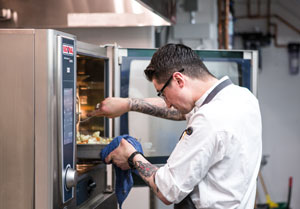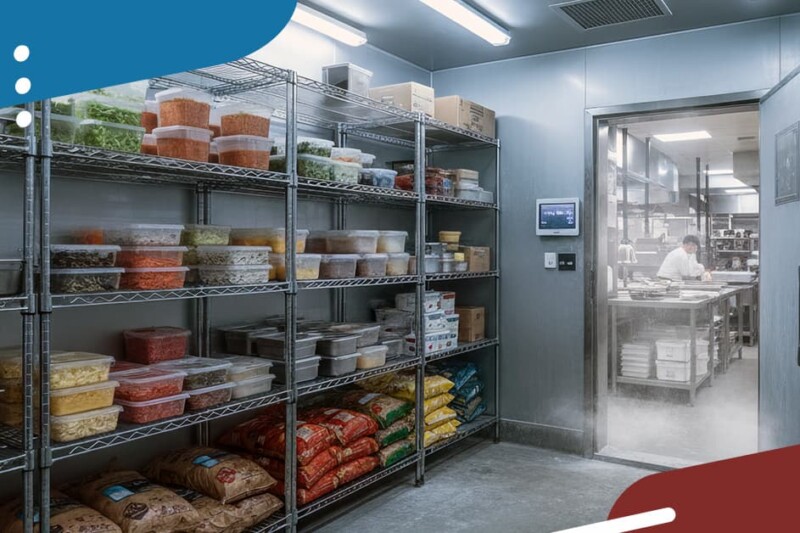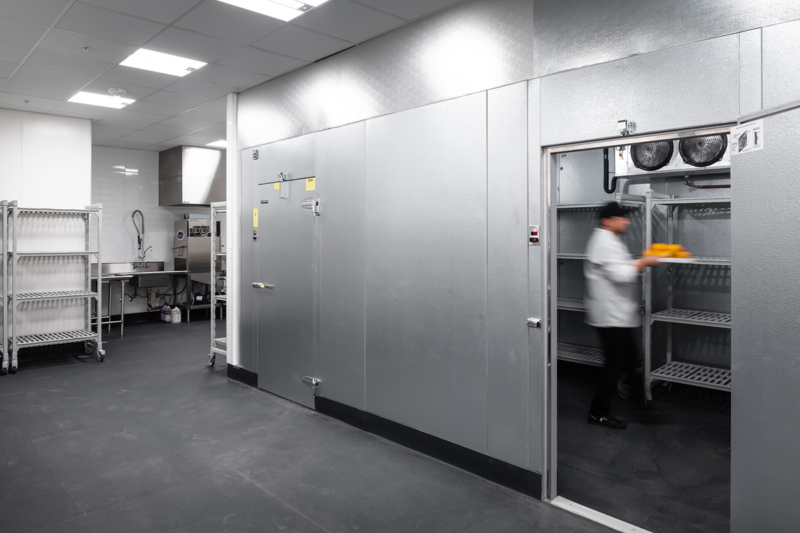
The combination convection oven/steamer, or combi, has been a fixture of more up-to-date commercial kitchens for quite a while—a couple of generations in Europe, and the better part of a generation in the U.S.
Adoption in American kitchens was slow at first, held back by the expense of these units and the industry’s perception that they were complicated and delicate. But changing conditions (including smaller kitchen footprints, the need for more versatile equipment to prepare a more varied and health-centric menu, and the rise of millennial chefs who are trained in combi cooking and comfortable with technology in general) have made these ovens more popular than ever before.
In large-scale kitchens, cooks tend to use combis in conjunction with other cooking equipment including convection ovens, steamers, fryers and smokers. But in smaller or more specialized settings, a combi can sometimes do the entire job. “Some operators are still focused on the idea that ‘I need a convection oven, a six-burner range and a fryer,’” says one source. “But the more seasoned, progressive or strategic operator knows that one combi can potentially eliminate all three pieces of equipment. And you can get greater throughput in a shorter amount of time.”
Combis today are more reliable, durable and offer substantial advancements in technology. Mini models and ventless options proliferate, as do power-enhancing, energy-saving and water-conserving features. Makers have combined new or improved touchscreen and touchpad controls with automated features that enable combis to do more. They’ve expanded cooking modes, including the addition of a smoker feature, and enhanced self-cleaning technology. Simpler maintenance is backed by better service networks.
Let’s take a closer look at a few of these developments.
Small Wonders, Self-Contained Hoods
In the past few years, a number of combi manufacturers have introduced mini tabletop models (holding four to six 12 x 20 x 2. hotel pans or half-size 18 x 13 sheet pans). These ovens are an attractive option for small operations with minimal needs (and limited space), and for larger kitchens requiring extra capacity. Purchasing a stack of two small combis rather than one floor-model unit means the ovens can be used for different applications at the same time—such as one for cooking, one for holding—and that there’s a backup oven functioning if one goes down.
Another option is the ventless hood, which some manufacturers offer factory-installed for tabletop combis only and others offer as an option for small, large and stacked models. Forgoing a standard hood is a major cost savings, since the cost per linear foot to install a permanent hood is substantial. A combi with a ventless hood still needs electrical access (the ventless option is not available for gas models) as well as a water hookup and floor drain, so there are limitations on where it can be placed. On the other hand, the hood mounts directly to the combi and there’s no overhead air clearance required above the combi-and-hood duo, which means it can squeeze into smaller spots than units under conventional hoods. (One manufacturer even has combi units that are UL-listed ventless for use without any separate hood; local codes prevail.) The pairing is ideal for small operations without the usual kitchen hookups, kitchens in old or historic buildings that forbid installation of new ventilation hoods, and bigger operations that need to find a place for an extra combi to ramp up production.
“These new combis are so exciting for companies that sell food but don’t necessarily have a kitchen or chef,” says one source. “They open up menu possibilities, like fresh-baked bread or really nicely done salmon for a salad.”
The option for sous-vide cooking, in which items are cooked in a vacuum-sealed bag for a longer time at low temperature with a special needle-probe thermometer, means that combi cooking need not involve handling raw food as part of the cooking process, she notes. (Employees do, of course, handle the raw food before it goes into the bags.) In sous-vide systems, the food retains flavor, nutrients, juices and size, and can’t overcook. A caution from one source: many health inspectors remain wary about the safety of sous-vide cooking and particularly the vacuum sealers required for the bags, so “you’ll have to have a HACCP plan.”
Specifiers considering a combi with a ventless hood should be aware that these systems differ. Some, which combine a catalytic system with a condenser to catch steam, may mean the combi should not be used to cook raw or skin-on meats. (One maker says its catalytic ventless system, but not others, is appropriate for raw proteins.) Others, which combine a disposable charcoal filter for odors with a washable steel filter for grease, are appropriate for heavier-duty applications such as grilling meats. One manufacturer offers two combis that have an integral system for limiting emissions of grease-laden vapors and are UL-listed for cooking without any separate hood or venting. Local code requirements may vary.
All About Controls
Some operations still prefer a combi with simple, easy-to-understand dial controls—on and off, hotter or cooler, more or less humidity. But manufacturers heavily promote models with new or improved touchscreens (touch-sensitive screen like that of a smartphone) or touchpads (similar to a touchscreen, but also sensitive to pressure and swiping motions).
Automated recipe programs can execute complex cooking jobs without manual intervention at various steps. Download these programs from a USB port, or even remotely via Wi-Fi (although that’s less common because of security concerns).
Bread baking is one example. “A combi oven using multiple stages can turn a frozen dough loaf into finished bread by thawing, proofing and baking,” says one chef. “You want a lot of moisture at the start of baking to let the dough expand and prevent it from crusting too fast, but once you’re done with the moisture, you want it out of the oven ASAP. The baking stages would be pre-heat, high-humidity combi stage, then convection with the vent open.”
Here’s another example of a program recipe: for smoked chicken wings, 80 minutes in the combi’s smoker mode, followed by 10 minutes at 300°F in convection mode with a high fan speed, followed by 15 minutes at 410°F in convection dehumidifying or “crisping” mode at top setting. Result: smoked wings that are crispy on the outside, moist on the inside. (Note that convection ovens don’t have the same humidity-removing mode.)
The sophistication of these combi ovens is remarkable. One manufacturer offers a twin control system that includes a dial and a touchscreen, touting simplicity and ease of use. Entry-level users can set the time and temperature, with the oven determining the appropriate optimal humidity. Alternatively, management can download up to 12 cooking programs for auto-display, allowing staff to simply touch a picture of the item to be cooked. Finally, advanced users can take control of all settings including humidity levels, fan speed and a food probe, and can program their own recipes.
Another company also has retained dial-control options while upgrading its capacitive touchpads that allow users to swipe to close a screen or to drag an unwanted program to the “trashcan.” The manual control offers options like steam on demand and a low-temperature roast-and-hold mode, while the digital-control mode features 99 programmable recipes with up to six cooking stages each.
A third combi maker differentiates itself with new “multi-touch” technology that allows users to control a large, 7-in. display screen by sliding, swiping or scrolling. A stroke of the finger can set the temperature and the percentage of humidity. There’s a quick mode for standard handling of predetermined operating sequences, but there’s also the opportunity to program up to 400 recipes and upload photographs denoting each one. The system remembers the last 20 cooking programs used.
Yet another manufacturer offers controls with onboard diagnostics of potential problems, multi-shelf cooking timers and what a company chef calls “more cooking programs than any operator will ever need”—backed by recipe and culinary assistance on the company website and from the manufacturer’s chefs. “When a combi goes into a kitchen where it’s never been used before, it can be a little overwhelming for employees,” the spokesman says. The chefs come in and train the staff, then come back and train again as needed.
Finally, one combi maker now styles its advanced models as “self-cooking.” Users enter on the controls information for the product and the desired cooking results, and the combi detects load quantity and size of the products loaded, and monitors status throughout the cooking process, adjusting energy levels as needed. The system allows for mixed loads on different shelves. This manufacturer offers networked cooking, which allows managers to check and control combis remotely, transfer and manage cooking programs, and download software updates.
Smoking Capabilities
With smoked meats, fish and even cheeses a current trend, one development that may be of interest if you’re wishing to expand your menu is the smoker option available with many combi models. Makers integrate the smoking mode into the cooking-program options on the unit’s control screen. (One limitation: smoking cannot be done under a ventless hood— traditional ventilation is required.)
One company gives you the option to use either briquettes or wood chips for smoking, while another maker’s units require wood chips. In some cases, you can choose a lighter or heavier smoking cycle, with cold smoking among the options. These models perform a cleaning cycle that, once selected, removes smoke residue so the combi’s ready for the next cooking cycle with no lingering odor or flavor transfer. Other combi brands do not require cleaning after the smoking cycle, a substantial time savings.
Don’t Get Your Hands Dirty
Self-cleaning systems have become another major differentiator for combi manufacturers. There are a number of reasons you might want to avoid assigning staff members to clean combis manually, including the fact that misuse of cleaning chemicals can cause damage to the combi, the staff member doing the cleaning, or both.
Manufacturers take different routes to simplify combi cleaning. Many models can start the cleaning cycle as soon as the combi stops cooking, with no need to cool down the cavity first. Every manufacturer’s system uses a premeasured product; some recommend a proprietary cleaner, while some give you the convenience and cost saving of choosing any recommended sanitation product. Some manufacturers specify a tablet cleaner, arguing that it’s easier for staff to use and there’s no chance of running out of cleaner without noticing it. (One tablet system incorporates chemicals for descaling as well as cleaning.) Other manufacturers use a liquid dispensed in premeasured quantities.
One company offers four cleaning levels, selectable at one touch, with automatic dispensing of cleaning fluids, including an eco mode (designed to economize on use of cleaning fluid, energy and water) and an express mode (for ultra-fast cleaning during business hours). Final steam-disinfection and drying cycles guarantee hygiene. Employees never touch hazardous chemicals.
Another manufacturer differentiates its system with an extremely quick 15-minute cleaning cycle (compared with an industry average of 30 minutes). Program alerts prompt cleaning of the unit after a set time, ranging from five to 24 hours. This maker uses a proprietary liquid cleaning system with a color-coded indicator on the combi control showing how much of the cleaning liquid is remaining.
A third company offers a self-cleaning system and a separate one-touch deliming system as a standard feature with its higher-end combis. The liquid cleaner is always hooked up. Combis can be connected to remote data access and controlled via Wi-Fi or LAN access—so a manager in a remote location can see if cleaning has been done regularly or even order a cleaning cycle, and technicians can remotely diagnose problems, including any issues with the auto-clean feature.
Manufacturers have their own motivations for emphasizing ease of cleaning. Today’s combis can take hard use and run 10 to 12 years, much longer than their predecessors of a decade ago, but only if they’re maintained. “The life of your combi depends on one thing: cleaning,” says one manufacturer. “The more often you clean it, the longer it will last.”
Combi Abuse—And How To Avoid It
Manufacturers and service agents report a few end-user-abuse stories about combis.
One high-level executive visiting a kitchen happened to observe a fellow slamming the combi’s door shut with a powerful kick. Then there was another individual who pierced the touchscreen control with his knife—he’d been poking it with the tool at hand, instead of his finger.
Some employees forget to wipe down the silicone door gaskets with soap and water daily, resulting in shredded gaskets and poor seals. Others neglect to clean debris out of the floor drain—or even pour waste grease right down the drain—leading to costly water backups. Some don’t bother to change water filters on schedule, causing scale buildup and shortening the combi’s life.
And then there are the overzealous cleaners who attack the combi with corrosive chlorine or floor cleaner rather than the liquid or tablet specified for the job. Others fail to dilute cleaning solution, and the concentrated liquid eats through neoprene tubing components.
Manufacturers note in users’ guides the daily, weekly, monthly and yearly steps to keep a combi purring. Follow them. Consider a maintenance contract; having servicers check out your oven on a regular basis can catch problems before they become major. Daily care includes washing down the gaskets and door with soap and warm water, then leaving the door open. To avoid grease buildup and carbonization, clean regularly with recommended chemicals at the right dilutions.
It all comes down to training. Staff members need to understand that a combi represents a substantial investment, that it’s important to slow down and treat it with TLC, that daily cleaning is essential—and how to properly complete the task. (And every new employee needs the same lecture.) One corporate chef shares what he did while running a restaurant to get buy-in: impress on the crew what was expected from them to keep the combi running, then give everyone a financial reward if nothing had gone wrong by the end of the year.
Click to the following page for the Combi Gallery.
RELATED CONTENT
- Advertisement -
- Advertisement -
- Advertisement -
TRENDING NOW
- Advertisement -
- Advertisement -
- Advertisement -


